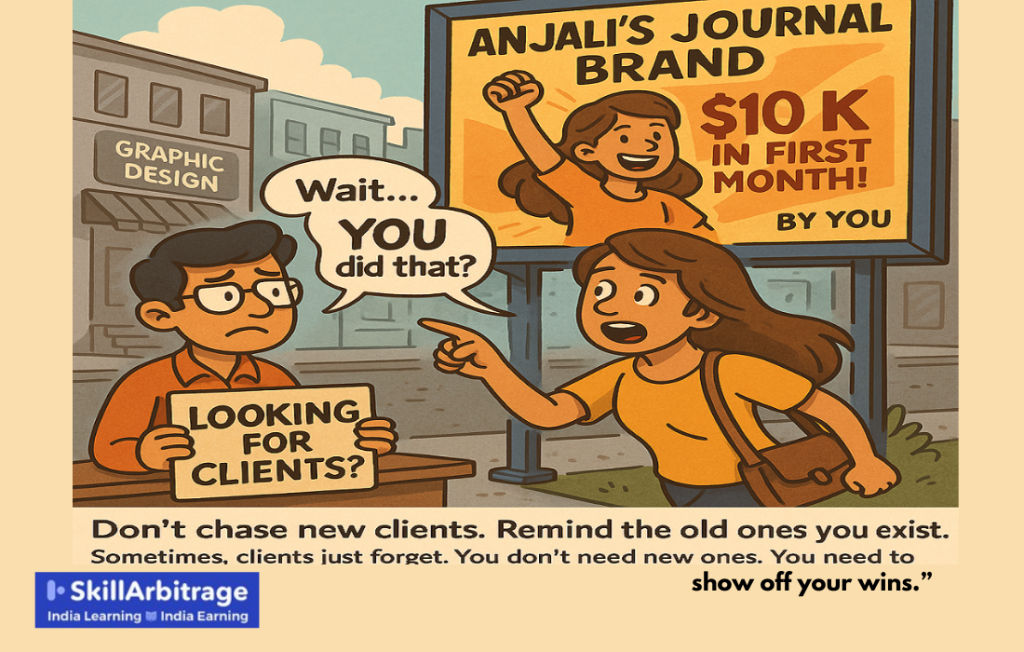This article is for Indian freelancers who’ve done real work, but it’s stayed invisible. You’ll learn why portfolios without proof fall flat and how to fix that using the “Proof Before Portfolio” method. By the end, you’ll know how to package your quiet wins into visible value that signals credibility and earns trust, not just attention.
Table of Contents
Previously on Beginner’s Guide…
Raja learned the fundamentals of working for brands from his sister, Swathi. He applied them to his friend’s journal brand. Now Raja knows what clients need. He sees the problems. He can map the fixes. But he’s still stuck. No big wins. No logos. No testimonials.
Now the question is…
How do you earn trust without a long track record?
(Continued…)
Raghunandan was halfway through his second coffee when he heard the iron gate creak. No buzz. No call. Just Raja, standing at the door like a schoolboy unsure if he’d missed the exam or still had a chance to write it.
He looked thinner. Not the gym kind of thin. The kind that comes from too much thinking and not enough winning.
Raghunandan raised an eyebrow. “Breakfast?”
Raja shook his head. Slumped into the chair across from him.
“I thought… I thought things were going well,” he started.
A pause.
“Swathi sat with me last month. Taught me the basics. Brand voice. Message clarity. Customer tension. I applied it all to Anjali’s journal business. Reshaped her site copy. Helped her write content that actually sounded like her. She says people are responding better now. One even messaged her, saying her page felt like a mirror.”
He smiled for half a second. Then it vanished.
“But still… no clients. No leads. I’ve posted twice. No one cared. I’ve sent samples. Nothing. Sometimes I think… maybe what I did doesn’t count. Maybe it’s too small. Maybe it’s not real work.”
He looked up.
“Or maybe I don’t know what I’m doing.”
You’re stuck, but not for the reasons you think
The wind shifted. Quiet rolled in.
Raghunandan didn’t reach for comfort. He reached for clarity.
He studied Raja’s face. Not with pity, but with precision.
Then, slowly, he said…
“You don’t need more wins, Raja. You need to make your first one louder.”
Raja frowned.
Raghunandan sipped his coffee.
“You don’t need more work. You need to show the work you’ve already done. Sharply. Loudly. Strategically.”
He placed his cup down.
“You think the work is too small. But the market isn’t ignoring you because your win is small. It’s ignoring you because it’s invisible.”
Most beginners have done more than they think
“Maybe it doesn’t count.”
Raja sat hunched over his chai, watching the steam twist and fade.
“I don’t know, man,” he muttered, not looking up. “Maybe what I did for Anjali doesn’t really count.”
Raghunandan said nothing. He let the silence sit.
“I mean, she’s a friend. It wasn’t even a paid gig. Just… helping out.”
One mistake almost everyone makes
Raghunandan leaned back, arms crossed.
“Let me guess,” he said. “You thought it wasn’t good enough to show.”
Raja shrugged. “It was just Anjali. A small business. No contract. No testimonial. No LinkedIn post saying I changed her life.”
Raghunandan nodded slowly. “That’s not the problem.”
Raja looked up. “Then what is?”
“You did the work,” Raghunandan said. “You just didn’t show it.”
He tapped the table once. The sound landed like a full stop.
“No one hires effort. They hire proof. And if they can’t see the proof, it doesn’t exist.”
Raja looked away. The words settled in like silt.
“So what,” he said quietly. “I just… talk about it?”
“No,” Raghunandan said. “You show it.”
“What does that even mean?”
Mini case study
Raghunandan leaned forward.
“What exactly did you do for her?”
Raja exhaled. “I helped her figure out her brand. What it stood for. We talked about why she started the journal line. I told her to lean into the daily ritual idea instead of branding it like some productivity hack.”
Raghunandan nodded. “Go on.”
“I rewrote her posts, too. They were too stiff. I made them sound more like her. Calmer, warmer. More like someone whispering, not shouting. She said it felt right.”
“And?”
“And I gave her ideas for Instagram. A journaling prompt series. Story polls. Stuff to get engagement going. It worked. Her DMs started blowing up. One of her followers, some wellness coach, even asked her to host a small workshop.”
He looked up again, eyes uncertain.
“But it’s still not a real project, is it?”
No proof, no signal
“The work was real.”
Raghunandan looked at him for a long second. Then said,
“Raja. That’s brand identity. Voice development. Content activation. That’s clarity, tone, and traction. You helped her sound like herself, stand out, and start conversations.”
Raja stayed quiet.
“You think that’s small?” Raghunandan asked. “That’s exactly what businesses pay thousands for. You just didn’t package it like that.”
He pulled a napkin toward him and drew a triangle.
Work → Proof → Signal
“You’ve done the work. Now make it look like proof. And turn that proof into a signal that clients can see.”
He looked up.
“Otherwise…”
“…it doesn’t exist,” Raja said, finishing the sentence for him.
Raghunandan smiled. “Exactly.”
He let the silence return. This time, it didn’t feel heavy.
“Proof before portfolio” method
Raja leaned in.
“So, how do I show it? I don’t have testimonials. Or fancy dashboards. Or whatever it is people post to look legit.”
Raghunandan smiled.
“You don’t need a portfolio yet. You need proof first. Then turn that proof into a signal.”
He took back the napkin, flipped it over, and started jotting three rough columns.
“First,” he said, tapping the top of the first one, “you frame the invisible.”
Frame the invisible
“You audit what you’ve already done,” he said. “Ask yourself…”
- “What problems did I solve?”
- “What thinking did I apply?”
- “What changed because of me?”
“You did more than tweak captions. You shifted brand positioning. You gave her a voice. You helped her audience see her differently.”
Raja blinked. “I mean… when you say it like that…”
“Exactly. Most of the value is hidden in your own memory until you shine a light on it.”
Turn it into tangible assets
Raghunandan moved to the second column.
“Then you package it. Tangible assets. Nothing too fancy. Just a few sharp proof points.”
He numbered them as he spoke.
1. Create a 1-pager case study.
Use the format: Problem → Insight → Action → Outcome.
Something clean you can attach to an email or proposal.
2. Build portfolios with proof on portfolio hosting wesbites.
Upload screenshots, Loom breakdowns, and sample content on websites like
“Make it Google-able. You want clients to find you without effort.”
3. Narrate the story on LinkedIn, Twitter, or Medium.
Turn the case study into a post or thread:
“What I learned turning a hobby journaling brand into a voice-led content machine.”
“Don’t just show the win. Share the thinking behind it.”
5. Repurpose for proposals on platforms like Upwork, Fiverr Pro, or Toptal.
“Instead of saying ‘here’s my work,’ say ‘here’s what changed because of me.’ That’s how you break through the noise.”
“Something like: ‘What I learned turning a hobby journaling brand into a voice-led content machine.’ Make it human. Make it useful.”
Raja scribbled it all down.
“This is gold,” he said. “And I don’t even need to pretend I worked with a big client.”
“You don’t need scale,” Raghunandan said. “You need sharpness. Proof of thinking. Proof of change.”
Optional add-on: Public risk-reversal offer
He added a final bullet under the third column and circled it.
“Want to go one step further?” he asked.
Raja looked up.
“Make a public offer. Say, ‘I’ll do for your brand what I did for hers. If it works, we work together. If not, you keep the strategy free.’”
Raja raised his eyebrows. “That’s ballsy.”
“It’s clean,” Raghunandan said. “And it makes your invisible skill visible. Fast.”
Raja sat back. The wheels were turning.
Three proof formats that create demand
Raja was scribbling furiously now. His chai had gone cold. He didn’t notice.
“This is already more than I thought I had,” he muttered.
Raghunandan nodded. “And we’re just getting started.”
He turned the napkin again and drew three shapes.
“These are the formats that make clients take you seriously. Think of them like lenses. Same proof. Different angles.”
1. Before/After story
“This one’s simple,” he said. “But powerful.”
“You tell the story of where the brand was, what you noticed, what you did, and what changed.”
Raja tilted his head. “So like… a glow-up post?”
“Exactly. But instead of selfies, it’s strategy.”
“You talk about Anjali sounding generic before. Then you rewrote her messaging. Then, followers started saying, ‘this feels like me.’ That’s emotional resonance. That’s conversion.”
2. Invisible work breakdown
“Most people only show results,” Raghunandan continued. “But great consultants show thinking.”
“This format is you walking someone through your process. The questions you asked. The blind spots you spotted. The tiny shifts you made.”
Raja nodded slowly. “Almost like teaching out loud.”
“Exactly. It positions you as someone who sees better than others. Not just someone who does.”
He tapped his pen again.
“Clients don’t hire hands. They hire eyes.”
3. Live proof offer
“This one is the boldest,” Raghunandan said. “But it works.”
“You go public and say, ‘This is what I did. If you want something like this, I’ll do it for free once. If it works, we work together.’”
Raja narrowed his eyes. “But won’t that attract people who just want free stuff?”
“Maybe. But if you’re sharp with how you filter and how you follow up, it turns into momentum. Fast.”
“You’re not begging,” he said. “You’re showcasing. That’s a different energy.”
How to make your proof of work cut through the noise
Raja looked up from his notes, brow furrowed.
“I’ve seen others post wins like this,” he said. “But they don’t get traction. It just floats past.”
Raghunandan didn’t answer right away. He pulled out his phone, scrolled for a second, then held it up.
“Look at this,” he said. “Case study. Good result. Zero likes. Why?”
Raja scanned the post. “It’s… dry? Feels like homework.”
“Exactly,” Raghunandan said. “Most proof fails because it reads like a résumé, not a revelation.”
He counted off on his fingers.
Problem 1: No context
“People just drop results without setting the stage. No one knows how hard the win was. Or what it really means.”
“You say ‘engagement doubled,’ but was it from 1 to 2, or from 100 to 200? And why should I care?”
Raja nodded. “So I need to make the stakes clear.”
“Exactly. Make me feel what wasn’t working before you show me what did.”
Problem 2: No character
“Cold proof dies fast,” Raghunandan said. “You need warmth. A story. A human.”
“Anjali wasn’t just a client. She was someone with a quiet mission who didn’t know how to speak out loud. That’s a story.”
“Make the reader root for her. Make them feel her win.”
Problem 3: No point of view
“This is the deadliest one,” he said. “Most posts just say, ‘Look what I did,’ but they don’t say what it means.”
Raja blinked. “What do you mean?”
“Insight,” Raghunandan said. “If you helped a quiet brand speak up, the takeaway is how voice builds trust. If you fixed scattered messaging, the takeaway is clarity converts.”
“Proof that teaches sticks longer. It travels. It earns trust.”
He sipped his now-cold chai and smiled.
“You’re not just sharing wins. You’re shaping beliefs.”
Turning one win into a positioning engine
Raja leaned back, still chewing on the last insight.
“So… one case study can shift how people see me?”
Raghunandan nodded.
“Most freelancers try to become visible by doing more. More posts. More cold DMs. More chasing.”
He leaned in.
“But real visibility comes when people start placing you. When they say, ‘He’s the guy who helps small brands find their voice.’ That kind of signal is sticky.”
Turn your narrative into your niche
Raja frowned. “But I don’t have a niche yet.”
Raghunandan smiled.
“You don’t need a niche. You need a narrative. A story that orients people.”
“You helped a small journaling brand go from timid to trusted. That’s not a niche. That’s a story about transformation.”
Raja nodded slowly.
“And if I tell that story right…”
“…you become the guy who sees what most people miss,” Raghunandan finished. “You don’t need ten client projects. You need one clear narrative that makes people say, ‘That’s exactly what I need.’”
Make the right people see themselves in your work
“You’re not showing off,” Raghunandan said. “You’re mirroring your future clients.”
“When they see Anjali’s journey, the right ones will think, ‘This feels like me.’ That’s how they reach out. Not because you pitched hard, but because you reflected who they were.”
Raja sat still. No fidgeting now. Just thinking.
“You’re not trying to be visible to everyone,” Raghunandan said softly. “You’re becoming obvious to the ones who matter.”
Your proof engine in 7 days
Raghunandan picked up Raja’s half-empty chai, swirled it, then set it down gently.
“You’ve got raw gold, Raja. But raw doesn’t sell. Finished does.”
He pulled out his notebook, tore a page, and started writing.
“Here’s what you build over the next seven days,” he said, sliding the page across.
Day 1-2: 1-Pager case study
“Start with the ‘Problem → Insight → Action → Outcome’ model. Keep it tight. Make it visual.”
Problem: Anjali’s brand felt generic and didn’t connect
Insight: It wasn’t a productivity brand. It was a ritual brand
Action: Shifted brand voice, rewrote captions, created activation content
Outcome: Higher DM engagement, workshop invite, better brand clarity
“Stick this in a Notion doc. Clean. Scannable. Shareable.”
Day 3-4: Screenshots + Loom breakdown
“Collect screenshots. Her old posts. Your new ones. Comments, DMs. Then record a Loom.”
“Here’s what it was. Here’s what I changed. Here’s why it worked.”
“This shows not just results but your thinking. That’s what clients really want.”
Day 5: Story post
“One LinkedIn post. Or a Twitter thread. Tell the story. Show your brain.”
What I learned turning a hobby journaling brand into a voice-led content machine.
“Be personal. Be specific. That’s what makes it real.”
Day 6–7: Gentle pitch
Raghunandan wrote the words in block letters.
I’ll do for your brand what I did for hers. If it works, we work together. If not, you keep the strategy free.
“Call it a risk-reversal offer. Call it public courage. Doesn’t matter. Just be clear. Be visible.”
Raja read the note once. Twice.
“This’ll work?” he asked.
“It already is,” Raghunandan said. “You’re just making it legible now.”
Raja folded the paper and slipped it into his pocket like it was more than a to-do list. Like it was permission.
“I always thought you needed a portfolio before you got clients,” he said, half to himself.
Raghunandan smiled.
“No. You don’t need clients to get proof. You need proof to get clients.”
He stood, stretched, and slung his bag over his shoulder.
“Start showing up like you already belong. The clients will catch up.”
Raja watched him walk away.
Then he pulled out the paper again.
Not to check what to do.
Just to remind himself he already had.
(To be continued…)







 Allow notifications
Allow notifications
